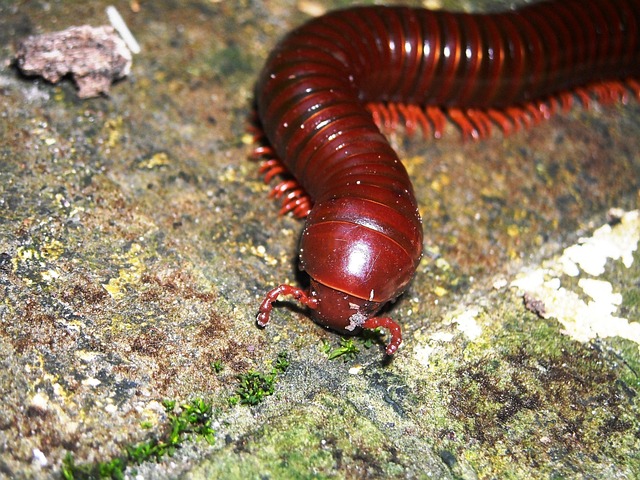Centipedes, moisture-loving arachnid pests found in humid areas like basements and kitchens, can be controlled using eco-friendly solutions that focus on understanding their behavior. Preventative measures include sealing cracks, maintaining sanitation, and proper drainage. Natural repellents like peppermint oil, diatomaceous earth, and heat treatments are effective deterrents. After successful removal, thorough cleaning and maintenance of a dry environment prevent reinfestation. Eco-friendly centipede solutions prioritize safety, effectiveness, and minimal environmental disruption.
Tired of unexpected centipede visitors in your home? This guide offers a discreet and efficient approach to centipede removal, prioritizing minimal disruption to your living space. We explore their behavior and habitat, providing insights into these multifaceted creatures. Discover effective, eco-friendly centipede prevention methods to keep them at bay. Learn about subtle removal techniques tailored for interior spaces. Finally, find post-removal care tips and preventive measures to ensure a pest-free environment with sustainable eco-friendly centipede solutions.
Understanding Centipedes: Behavior and Habitat
Centipedes are multi-legged pests known for their long, slender bodies and distinct appearance. They are arachnids, related to spiders and scorpions, but unlike their spider cousins, centipedes actively hunt and feed on other insects and small creatures. These creatures prefer moist environments, making them commonly found in areas with high humidity like basements, bathrooms, and kitchens. Their natural habitat includes dark, hidden spaces behind walls, under floors, or within piles of organic debris. While they primarily feed on other insects, centipedes may occasionally bite humans if handled incorrectly or cornered, causing a stinging sensation.
Understanding their behavior is crucial when devising eco-friendly centipede solutions. Centipedes are solitary creatures and prefer to avoid human contact. They are most active at night, making them less noticeable during the day. Implementing simple preventive measures like sealing cracks and gaps around pipes, maintaining excellent home sanitation, and ensuring proper drainage can significantly reduce their population. Regular inspection and prompt removal of any centipede sightings through safe, non-toxic methods are key to maintaining a centipede-free living space while keeping your environment healthy and safe.
Eco-Friendly Methods for Centipede Prevention
When dealing with centipedes, it’s essential to consider eco-friendly centipede solutions for prevention and control. Instead of relying on toxic pesticides that can harm both pets and beneficial insects, there are several natural methods to keep these pests at bay. One effective approach is maintaining a clean and dry environment, as centipedes thrive in damp spaces. Regularly checking and fixing leaks, improving ventilation, and removing sources of standing water can significantly reduce their presence.
Another eco-friendly method involves utilizing essential oils known for repelling centipedes. Natural oils like peppermint, lemon eucalyptus, and cedarwood have proven to deter these creatures. Sprays or diluted oils can be applied in areas where centipedes are commonly found, offering a safe and non-toxic alternative to chemical treatments. Additionally, introducing natural predators like spiders and centipede hunters can help manage the population while maintaining balance in the ecosystem.
Discreet Removal Techniques for Minimal Disruption
When it comes to centipede removal, a discreet and efficient approach is preferable for both homeowners and the environment. Traditional pest control methods often rely on toxic chemicals that can leave harmful residues and disrupt ecosystems. Instead, opt for eco-friendly centipede solutions that prioritize safety and minimal disruption. One such technique involves using natural repellents like diatomaceous earth or essential oils, which are effective in deterring centipedes without causing any significant harm to people or pets.
Another discreet removal technique is heat treatment. This method uses heated air to eliminate centipedes by raising the ambient temperature beyond their tolerance levels. Heat treatments are highly targeted and can be applied to specific areas, minimizing damage to non-target species and structures. Additionally, sealing entry points and maintaining a clean environment can significantly reduce centipede infestations over time, providing a long-lasting solution with minimal disruption.
Post-Removal Care and Preventive Measures
After successfully removing centipedes from your space, proper post-removal care is essential to prevent reinfestation and maintain a pest-free environment. Start by thoroughly cleaning the affected areas with eco-friendly cleaning products to eliminate any residual traces of the pests and their eggs. Vacuum floors and wipe down surfaces, paying close attention to corners and crevices where centipedes tend to hide.
To prevent future centipede invasions, consider implementing some eco-friendly centipede solutions. Seal entry points and cracks in walls, foundations, and doors using caulk or weatherstripping. Ensure proper ventilation in attics and crawl spaces, as centipedes are attracted to damp and dark areas. Regularly inspect and maintain your home’s plumbing for leaks, as centipedes are drawn to moisture. Lastly, keep your space clean and clutter-free, as hidden spots provide ideal hiding places for these pests.
Centipedes may be unwelcome intruders, but with a combination of understanding their behavior and employing discreet, eco-friendly removal techniques, it’s possible to minimize disruption to your living space. By preventing their return through targeted measures, you can enjoy a pest-free environment without resorting to harsh chemicals. Remember, proper post-removal care and proactive preventive steps are key to maintaining a comfortable and insect-free haven. Embrace these eco-conscious solutions for a harmonious coexistence with nature’s creatures, both seen and unseen.
